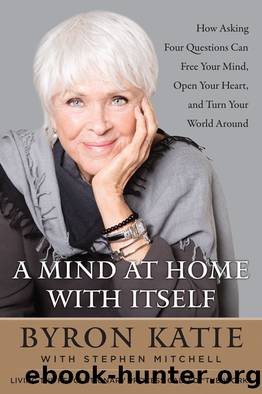A Mind at Home with Itself: How Asking Four Questions Can Free Your Mind, Open Your Heart, and Turn Your World Around by Byron Katie

Author:Byron Katie
Language: eng
Format: epub
Publisher: HarperCollins
Published: 2017-08-06T00:00:00+00:00
This chapter contains a variation on the truth that the Buddha stated in chapter 10: âA bodhisattva should develop a mind that abides nowhere.â Here he says, âThe mind should be kept independent of any thoughts that arise within it. If the mind depends upon anything, it has no sure refuge.â To see things just as they are, you would need to think only in what I call âfirst-generation thoughtsâ: single nouns, with no other words attached to themâfor example, âtree,â âsky,â âtable,â âchair.â But even tree, sky, table, and chair have to be questioned, since any point of reference is pure imagination. So itâs not a table, though you call it a table; itâs not a tree, though you call it a tree. Calling it something doesnât make it the something you call it.
Nothing is ultimately true; thereâs nothing that canât be questioned. The last reality is âThere is no reality,â and I invite you to go beyond even that. You can find no anchor, no identity, no self. And thatâs the safe place. Thatâs the sure refuge.
If the mind depends upon anything, it becomes the I-know mind, an ego flailing around in apparent space and time, always trying to define itself, always trying to prove that its judgments are real, that its whole world is real. The mindâs only way out is in: the mind inside itself, Buddha-mind, responding to the illusion of a self. Once the illusion is questioned, it can no longer exist. It appears as inconsequential, funny, and completely insane.
In the story that the Buddha tells in this chapter, about when he was being tortured, he was awake to the fact that the hands, feet, ears, and nose that were being chopped off werenât his. The body wasnât his body. It was no oneâs body. He realized that it was all imagined, so no thought could arise that would cause anger or hatred in him.
I havenât been tortured, but a number of times I have been threatened by violent people, and I know that itâs possible to stay rooted in the real even when youâre in apparent danger. To my mind, this isnât a matter of patience; itâs a matter of noticing, witnessing, and staying connected to reality.
For example, sometime early on, in 1986 or â87, I was doing The Work with a woman from Kansas City who had come to stay with me for a few days. She said she suffered from chronic pain. One day, as she was leaving, I put my arms around her. According to her, a shock went through her, and she said, âOh my God, the pain is gone!â She burst into tears and said I was a great healer. I told her that whatever had happened resulted from her projecting this role onto me so powerfully, but it was all her; she was the one who had healed herself. After this, she kept flying back to Barstow and spent as much time as she could hanging out with me, living in my house.
Download
This site does not store any files on its server. We only index and link to content provided by other sites. Please contact the content providers to delete copyright contents if any and email us, we'll remove relevant links or contents immediately.
The Concise Laws of Human Nature by Robert Greene(1779)
Bioenergetica by Alexander Lowen(1414)
After by Bruce Greyson(1287)
The Child in You by Stefanie Stahl(1189)
No Bad Parts by Richard C. Schwartz(1156)
Stress-Proof Your Brain The Yogic Way: Unique Ancient Indian Techniques to End Toxic Stress, Stop Worrying and Inculcate Mental Toughness by Advait(1089)
Talk of the Ton by unknow(1005)
Badass Habits: Cultivate the Awareness, Boundaries, and Daily Upgrades You Need to Make Them Stick by Jen Sincero(1005)
The Power of Myth by Joseph Campbell & Bill Moyers(987)
Chakras & Self-Care by Ambi Kavanagh(918)
Self-Care for Empaths by Tanya Carroll Richardson(876)
Learn To Think Using Thought Experiments by King Patrick(861)
The Mind by E. Bruce Goldstein(851)
Curative Magic by Rachel Patterson(830)
The 7 Secrets of Sound Healing Revised Edition by Jonathan Goldman(830)
The Quantum Psychiatrist: From Zero to Zen Using Evidence-Based Solutions Beyond Medication and Therapy by Biswas Dona(819)
Living a Life of Awareness by Don Miguel Ruiz Jr(818)
The Tao of Intimacy and Ecstasy by Solala Towler(814)
The Anxiety First Aid Kit by Rick Hanson(813)
